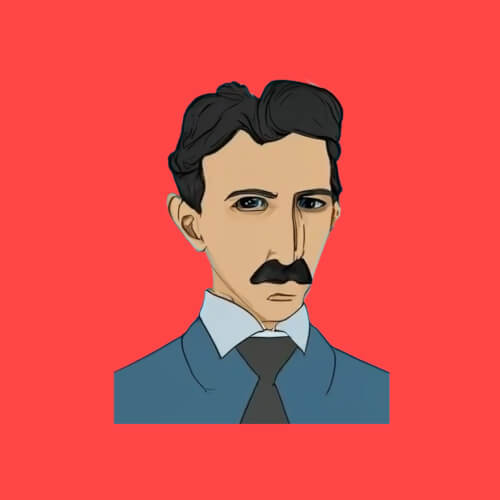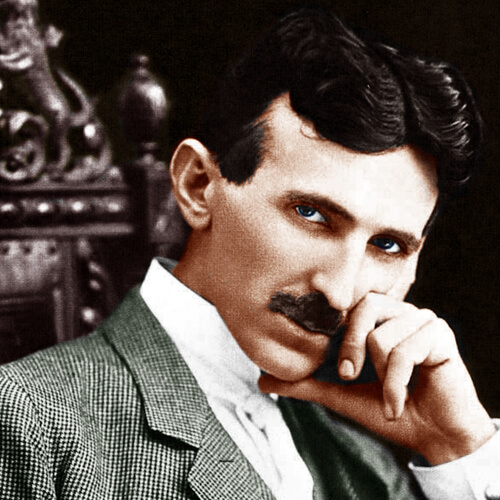



Nikola Tesla (10 July 1856 - 7 January 1943) was a Serbian-American inventor, electrical engineer, and physicist, whose work in the field of electrical engineering helped lay the foundation for modern power systems. Known worldwide for his contributions to the development of alternating current (AC) electrical systems, he also made great contributions to the fields of wireless communication and robotics.
Tesla was born in 1856 in Smiljan, Croatia (then part of the Austrian Empire). His father, Milutin Tesla, was a Serbian Orthodox priest, and his mother, Djuka Mandic, was an inventor of household appliances. From an early age, Tesla showed an exceptional abilities in mathematics and science as well as languages.
At the age of 17, Tesla became sick with cholera for 9 months and nearly died. Fortunately, he recovered and, though his father wanted him to become a priest, he went on to attend the Austrian Polytechnic University in Graz. After stopping his studies during his 3rd year and before earning his diploma, Tesla moved to the United States in 1884, where he began working for the inventor and entrepreneur, Thomas Edison.
One of Tesla's most important achievements was his invention of the alternating current (AC) electrical system, which completely changed the way that electricity was generated and distributed. In alternating current, the electrical current alternates directions (forward and reverse), which is different from direct current's (DC) one-way flow. Tesla's AC system allowed sending electrical power more safely over long distances, making it possible to generate electricity at central power plants and distribute it to homes and businesses around the world.
In addition to his work on AC power systems, Tesla made many other important contributions to engineering and science. He invented numerous devices that are still used today, including the Tesla coil, which is used to generate high-voltage, low-current electricity, and the induction motor, which is used in many household appliances and industrial machines. Tesla was also a pioneer in the field of wireless communication, and he made important contributions to the development of radio technology.
Growing up, Tesla's native language was Serbo-Croatian, a language spoken in a few different countries in Eastern Europe, including Serbia, Croatia, Bosnia and Herzegovina, and Montenegro. Throughout his life, he became fluent in an amazing additional 7 languages: Czech, English, French, German, Hungarian, Italian, and Latin.
In his autobiography, My Inventions, Tesla wrote about his belief that a plant-based diet was better for both the human body and the planet. He even wrote an article for a vegetarian magazine in which he argued that humans were not designed to be carnivores, and that eating meat was a "perversion" of our natural diet. While it does appear that he may have eaten meat at some points in his life, most people who knew him state that he was a strict vegetarian, even avoiding animal products like milk and eggs altogether.
Tesla's biographer, John O'Neill, wrote that Tesla had a remarkable ability to recall entire books from memory and visualize complex designs in his mind. O'Neill reported that Tesla, "Could repeat page after page of words, mathematical formulas, or poetry after one reading," and that "he never made a mistake, never lost a word." Tesla himself once said, "My memory is so good that I seem to see things as if they were being enacted before me."
Tesla avoided touching anything "dirty" or "unclean," including doorknobs, handrails, and even other people's hands. He was known to carry a stack of clean towels with him wherever he went, using them to cover his hands when opening doors or pressing elevator buttons. He was also known to change his clothing frequently, sometimes several times a day.
Tesla's germaphobia was likely because of an intense fear of disease. Tesla's mother died from cholera when he was young, and he himself suffered from numerous illnesses, including malaria and pneumonia. His fear of disease was so intense that he reportedly refused to attend his own mother's funeral for fear of catching cholera.
As an example, the 2006 movie The Prestige presents a fictional version of Tesla as one of the lead characters. Perhaps most significantly is the car company, Tesla Motors, also named after the great inventor in 2003 by Martin Eberhard and Marc Tarpenning. Today, Tesla Motors is largely operated by Elon Musk, an inventor and one of the world's richest billionaires.
While Tesla did make some money off of his inventions during his lifetime, he was never able to secure the long-term financial backing that he needed to fund his many projects. Tesla was also known for being eccentric and unpredictable, which may have made investors hesitant to support his work.
Towards the end of his life, Tesla became increasingly solitary and focused on his research, ignoring his finances. This, in addition to his declining health, meant that Tesla died with little to his name.
In 1884, just 6 years after the first electric street lights were installed in London, Tesla moved to the United States and began working for Thomas Edison, then already a famous inventor and engineer. Not long after, differences in their ideas began to grow, which eventually led to a bitter feud. Edison believed that the best was to power buildings was with direct current (DC), while Tesla believed in using alternating current (AC).
Edison saw Tesla as a threat to his dominance in the engineering world and did everything in his power to discredit him. He even publicly called Tesla's AC "the current of death." Nevertheless, Tesla convinced businessman George Westinghouse to invest in his AC technology which eventually became the standard way of transmitting electricity and still is today.
In 1901, Tesla began work on what became known as the Wardenclyffe Tower. At this time, the telephone was only 25 years old, and the telegraph was one of the main ways people communicated over large distances. Tesla envisioned a tower that could easily, wirelessly send messages across the ocean. He also used the tower to experiment with the idea of wireless power transmission—kind of like the way today's wireless phone chargers work, only Tesla wanted to provide power to lots of people.
Sadly, Tesla ran out of money and time and in 1906 the tower became abandoned. In 1917 the tower was completely destroyed and its metal components sold for scrap.
In 2006, Serbia's main international airport was renamed as the Belgrade Nikola Tesla Airport. Today, it is a hub for several airlines, including Air Serbia, Wizz Air, and Ryanair, and offers flights to over 70 destinations across Europe, Asia, and Africa. In 2023, the airport reported ticket sales to 5,611,920 passengers.